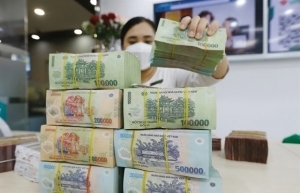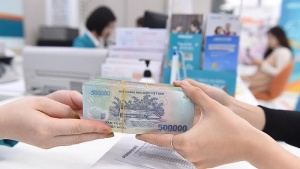SBV offers fresh catalyst for growth
 |
| Moves by some banks to lower rates send positive signals of interest rate stabilisation |
Last week, the central bank (SBV) continued to inject liquidity through the open market operations, with a value of approximately $1.39 billion, offering tenors of 7-14 days at an interest rate of 4.25 per cent.
Since August 26, the SBV has halted the absorption of funds via treasury bills and shifted to a net injection stance to support banking system liquidity, thereby helping to reduce interbank interest rates as exchange rate pressures have eased.
Thanks to the SBV’s interventions, interbank interest rates have decreased significantly. Specifically, the overnight rate has dropped by 50 basis points compared to earlier in the week, now standing at 3.8 per cent, while rates for terms under one month currently fluctuate between 4.1 per cent and 4.3 per cent. Additionally, some banks, such as OCB and ABBank, have reversed the trend of raising interest rates.
“There are still many banks listing high interest rates, especially large banks. However, the moves by these banks to lower rates also send positive signals of interest rate stabilisation, which supports businesses seeking loans and encourages credit growth, which has been sluggish,” said Dr. Nguyen Tri Hieu, a financial expert.
In efforts to stimulate credit growth, the SBV announced that from August 28, credit institutions achieving 80 per cent of the credit growth target set by the central bank at the beginning of 2024 will be allowed to increase their credit ceilings based on their ranking scores.
“Liquidity in the economy has started showing signs of recovery. Certain sectors, particularly processing industries and agriculture, are more likely to see expanded credit lines,” said Dr. Le Xuan Nghia, an economic expert. “However, I maintain my stance that the trend may gradually move towards the elimination of credit ceilings, with the SBV controlling credit through official regulatory instruments. Market-driven operations are more sustainable in the long term, while administrative credit ceilings will become increasingly irrelevant.”
Banks are eager to boost credit growth, and lending rates have fallen, indicating that supply is ready. Experts believe the key factor for credit growth moving forward is the actual pace of economic recovery.
“From the perspective of the government, the SBV, and the banks, everyone is eager to lend more, and the current low lending rates reflect the readiness on the supply side,” said a Maybank representative. “The decision to grant additional credit limits to banks, particularly those capable of expanding credit effectively, is another driver for credit growth. This underscores the determination to ensure sufficient liquidity and capital for the economy. However, the more difficult variable to forecast is the pace of economic recovery, which will dictate credit demand.”
He noted that a 14-15 per cent credit growth target for this year is achievable.
“Given the low base in the first six months of 2023, we expect credit growth to be more robust this year, with a projected increase of 12-13 per cent in the first half compared to the same period last year. A key positive development is the faster-than-expected recovery in the real estate sector, likely to be significant by the end of Q3,” the representative added.
Dorsati Madani, senior economist at the World Bank in Vietnam told VIR that stronger-than-expected global economic growth could sustain Vietnam’s export sector.
“Looser monetary policies in major developed economies, initiated by the European Central Bank and the Bank of England, coupled with signals from the Federal Reserve of a potential rate cut in September, may continue to drive aggregate demand in developed markets and bolster Vietnam’s exports,” Madani said. “This could also help reduce global fundraising costs and narrow the interest rate differential, creating positive spillover effects for Vietnam’s banking and financial sectors.”
 | New policy promotes green banking development in Vietnam The State Bank of Vietnam (SBV) is pushing all credit institutions to go green in terms of banking and credit. |
 | Bad debt risks make banks switch focus Vietnamese banks are increasingly shifting their focus from retail lending to corporate clients, driven by concerns over rising bad debts in the retail segment and heightened risk perceptions. |
 | Uneven credit growth registered in first eight months Credit growth rebounded in August after July's slowdown, but it remained uneven, with Hanoi's rate nearly triple that of Ho Chi Minh City. |
What the stars mean:
★ Poor ★ ★ Promising ★★★ Good ★★★★ Very good ★★★★★ Exceptional
Related Contents
Latest News
More News
- Tax sector wraps up 2025 and sets priorities for next year (December 25, 2025 | 14:00)
- A tipping point for digital and hybrid wealth management in Vietnam (December 23, 2025 | 13:33)
- $250 million deal targets women-owned SMEs, sustainable agriculture (December 22, 2025 | 17:40)
- Stock market posts resilient 2025 performance (December 19, 2025 | 18:17)
- Citi Vietnam receives 2025 AmCham CSR recognition (December 19, 2025 | 16:35)
- As global green supply chain reshapes, will Vietnam be left behind? (December 19, 2025 | 08:00)
- Banks gear up for massive capital increases (December 18, 2025 | 17:04)
- Securing capital and efficiency for Vietnam’s 2026-2030 growth ambitions (December 17, 2025 | 10:00)
- Energy sector in need of blended finance mechanisms (December 17, 2025 | 09:00)
- Vietnam still has room to mobilise capital for sustainable growth (December 17, 2025 | 08:57)

 Tag:
Tag:





















 Mobile Version
Mobile Version